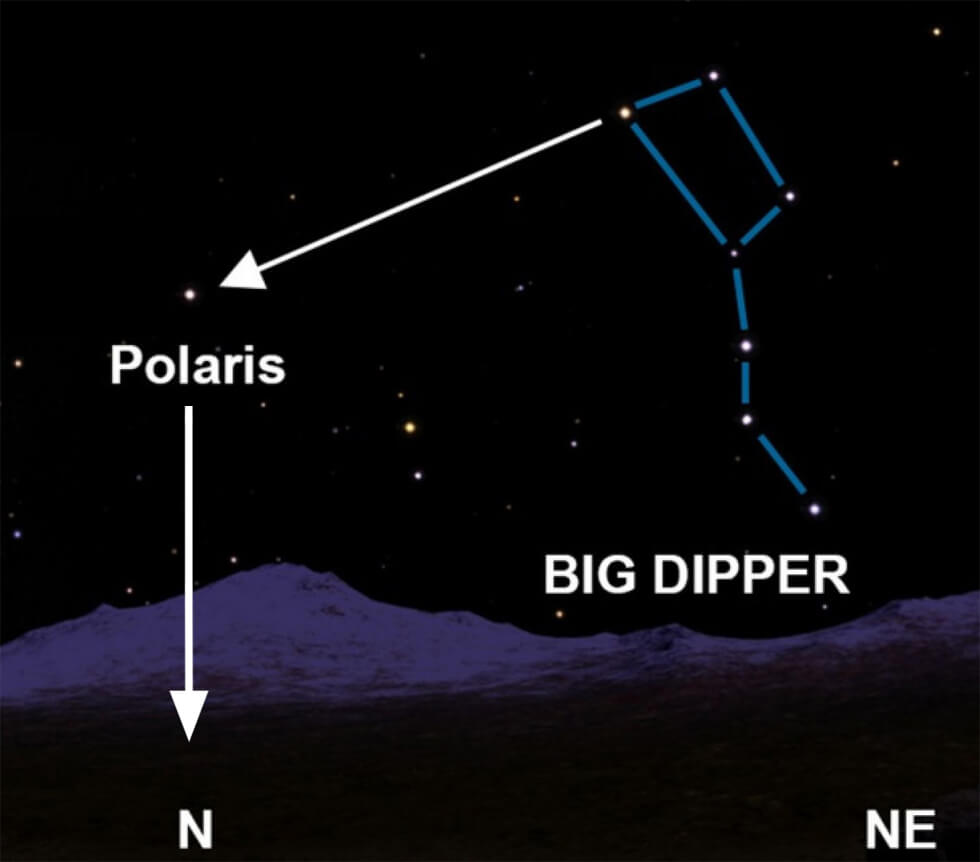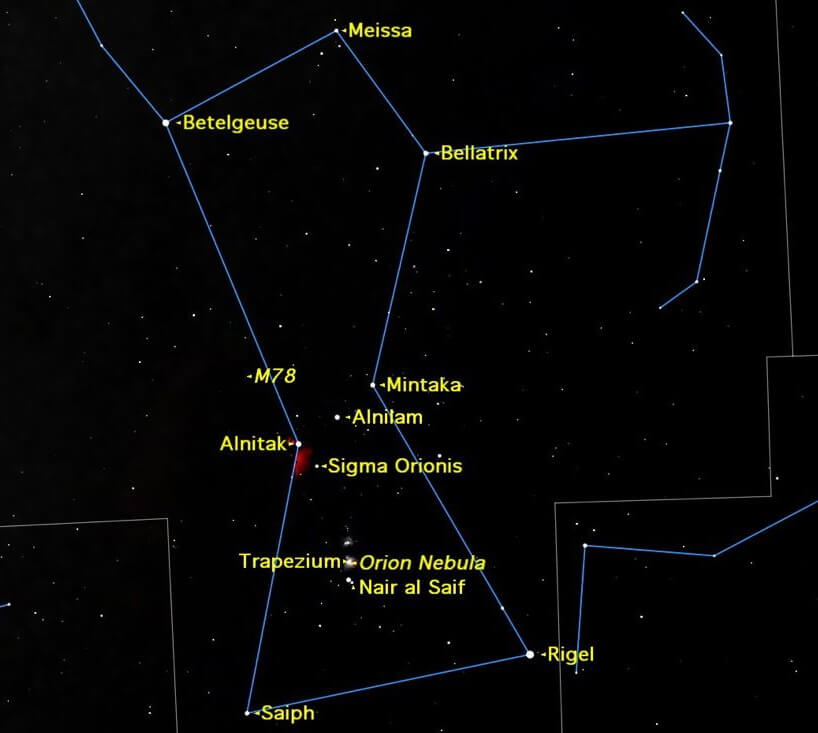Long before the invention of GPS and compass, our ancestors were navigating the seas and the plains using the stars. The ancient people relied on the stars and constellations to safely guide them home. The stars are permanent markers in the night sky, and can be used for navigation even today.
So how do you navigate by the stars? There are several proven methods, both for Northern and Southern hemispheres. I list these methods in the article. I also explain how to recognize famous constellations that can aid your navigation.
How to Navigate by the North Star
- Locate North Star, AKA Polaris. This star sits almost exactly at the Celestial North Pole and does not move throughout the night. If you lower an imaginary line directly to the horizon, you have found north.
- Use pointer stars if you cannot locate Polaris right away. Look for Ursa Major constellation, AKA the Big Dipper. Dubhe and Merak stars form the wall of the dipping part of the Dipper, farthest from its handle. Stretch a line through them and away from the mouth of the dipping part. At 5 lengths of this line you will find the location of the North Star, even if it’s hidden by clouds.
- Use Pegasus’s Great Square, if the Big Dipper is still below the horizon. Stretch a line from Alpheratz, one of the Square’s corner stars, to Caph, the right edge star of Cassiopeia constellation, if it’s viewed as a W letter. Continue this line for the same length again, and you arrive within 3 degrees from the North Star.
- Use the middle star of Cassiopeia’s W formation, Gamma.
The following image demonstrates how Polaris can be easily located:

How to Navigate by the Southern Cross
- Locate the Southern Cross, AKA Crux. This Southern Hemisphere constellation will help you to find the South Celestial Pole. The Southern Cross is formed by 4 stars, which are the 4 points of the cross formation. It’s a very famous and easily recognizable constellation in the Southern Hemisphere, featured on both Australian and New Zealand’s flags.
- Create an imaginary line that goes through the cross’s axis. The south is located at the point on this line. The point sits at about 4 lengths of the long axis. This is the South Celestial Pole.
- Look straight down from the South Celestial Pole toward the horizon. This is the south direction.
- An option method is to create a line between 2 point stars nearby, Hadar and Rigil Kentaurus. From the center of this line stretch a new line, at 90 degrees, in the direction where the cross’s long axis points. At the intersection of this line and the previous mentioned cross’s line you will find the South Celestial Pole.
The following image demonstrates how to navigate by Southern Cross:

How to Find West or East by the Stars
- Locate Orion. This famous constellation resembles a somewhat misshapen hourglass.
- Notice Mintaka, the right star on Orion’s belt.
- During the first 3 hours of its rise, you can trace it back toward horizon to find east.
- Conversely, during the last 3 hours, as it sets, you can trace it toward the horizon to find west.
The following image of Orion will help you familiarize more with this noticeable constellation:

How to Find South by Orion
- Locate Orion. Again, it looks like a misshapen hourglass made of four stars which symbolize Orion’s shoulders and knees.
- Notice Orion’s Belt, the three stars that create a straight line in the middle of this constellation.
- Trace your eyes down from Alnilam, which is the middle star on Orion’s Belt.
- Find a fuzzy looking star below, that’s known as Orion’s sword. The star is in fact a nebula that can be seen with a naked eye. Orion’s sword points in the south direction.
How to Navigate and Find Direction Using Any Star
- Take two sticks or stakes and drive them into the ground, with approximately 1 meter or 1 yard between them.
- Select any star you wish to focus on, preferably one of the most brightest and easy to follow stars.
- Create an imaginary line that connects both stakes’ tops and the star.
- Check on your target star after a while. Our planet rotates to east, which means that the stars rotate to west. Once your target moved out of the alignment with the stakes, notice where it moved. This will help you to find the direction you’re looking at, according to the following rules:
- You’re looking in the west direction if the star descended.
- You’re looking in the east direction if the star ascended.
- You’re looking in the south direction if the star shifted to the right.
- You’re looking in the north direction if the star shifted to the left.
How to Find the Latitude by the Stars
- Find the North Star. At this point you can easily recognize it.
- Measure the angle between the north point of the horizon and the star’s position. You can use a sextant or quadrant, which can precisely tell the angle in degrees. This is your latitude, measured from the equator to the north.
- If you don’t have a sextant or quadrant, extend your arm towards the horizon and make a fist. The fist will symbolize about 10 degrees of latitude. Stack fists one on the other until you touch the star, and multiply their number by 10 to get the approximation of your latitude.
The following excellent video by Atlas Pro summarizes the star navigation techniques mentioned earlier:
How to Locate Helpful Constellations and Navigate by Them
As you know, constellations are groups of stars that are forming visible patterns in the night sky. Many of them are named after mythological heroes and creatures.
Constellations play an important part in the astronavigation (navigation by the stars), as I showed you earlier in the article. Knowing how to locate and recognize them is highly important for any navigator. Keep in mind that some of them shift their location throughout the year, as the Earth makes its way around the Sun. Other, however, stay constant in the sky, and they are known as circumpolar constellations.
Since circumpolar constellations can be seen all year long in their hemisphere, we use them to navigate by the stars. We can use them as a reference point, because we can always find them by looking up. I will list the most famous circumpolar constellations and their role in the astronavigation.
- Ursa Major: It’s commonly known as the Big Dipper or the Great Bear, and is an easily recognized constellation in the Northern Hemisphere. It contains 7 brightly shining stars that form a shape of a ladle (hence, Dipper). The last two stars of this ladle (the wall of the “dipping” part, the farthest from the ladle’s handle) make a line that points to Polaris, the North Star, which, as I already explained, is used to find the north.
- Cassiopeia: If Ursa Minor is not visible, you can use Cassiopeia to locate the North Star. Cassiopeia looks like a W or M. From the middle of the left V (if you see a W) or the right angle (if it’s an M) draw a straight line that splits in two. Just imagine sending a straight arrow from that V/angle. It will lead you to the North Star.
- Ursa Minor: This is the Little Dipper/Little Bear, and it looks like a smaller version of Ursa Major. The last point of this little ladle is the famous North Star.
- Orion: One of the most easily spotted constellations, it can be seen even from a city. It looks like a hunter who grips a bow. 5 stars make his head, shoulders and feet. 3 additional stars create the famous and bright Orion’s Belt. Navigators have been using Orion as a reliable reference point for many years.
- Centaurus: Among the biggest constellations in the Southern Hemisphere. Named after a half-man/half-horse being from Greek mythology. Along with Crux (see below), it’s used to find the direction to south.
- Crux: Also called the Southern Cross, this Southern Hemisphere’s constellation is the most important one in astronavigation. As explained earlier, it’s utilized to locate the south. This is a tiny constellation, but it’s easily recognized thanks to its 5 stars that make an approximate form of a cross. If you’re at the latitude of 27 degrees north and below, you will see it in the night sky.
Final words
Hopefully I was able to help you in your future adventures, and now you know how to navigate by stars, no matter where you are.
Navigating by stars is not the only survival skills you need to learn. I have made a list of basic survival skills, be sure to check it out. In addition, you can navigate using a compass, as long as you choose the right compass.
There are tons of important and useful information on my blog, I cordially invite you to search and browse the articles. And above all, stay safe out there!


